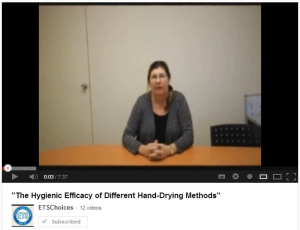The flagship journal of Mayo and arguably one of the premier peer-reviewed clinical journals in general medicine, Mayo Clinic Proceedings is among the most widely read and highly cited scientific publication for physicians, with a circulation of approximately 124,000. Continuously published since 1926, the Proceedings content includes Nobel-prize-winning research. Among other studies, the authors also reference the University of Westminster 2008 study for ETS (and the university of Bradford Study, supported by an electric dryer manufacturer).
This important article, published in June 2012 in the peer-reviewed clinical journal “Mayo Clinic Proceedings”, concludes that regarding hygiene there is a clear superiority of Paper Towels vs. Electric Air Dryers.
Abstract of the article
“The transmission of bacteria is more likely to occur from wet skin than from dry skin; therefore, the proper drying of hands after washing should be an integral part of the hand hygiene process in health care.
This article systematically reviews the research on the hygienic efficacy of different hand-drying methods.
A literature search was conducted in April 2011 using the electronic databases PubMed, Scopus, and Web of Science. Search terms used were hand dryer and hand drying.
The search was limited to articles published in English from January 1970 through March 2011. Twelve studies were included in the review.
Hand-drying effectiveness includes the speed of drying, degree of dryness, effective removal of bacteria, and prevention of cross-contamination.
This review found little agreement regarding the relative effectiveness of electric air dryers.
However, most studies suggest that paper towels can dry hands efficiently, remove bacteria effectively, and cause less contamination of the washroom environment. From a hygiene viewpoint, paper towels are superior to electric air dryers. Paper towels should be recommended in locations where hygiene is paramount, such as hospitals and clinics.”
“The 2009 human swine influenza A (H1N1) pandemic reminded health professionals and the community of the importance of hand hygiene to prevent the spread of diseases.
The effectiveness of hand hygiene in infection control has been recognized since Semmelweis’s observation in 1847 that the implementation of hand washing reduced the number of deaths among women with puerperal fever. For centuries, hand washing has been considered the most important measure to reduce the burden of health care–associated infection.
Hand washing refers to washing hands with plain or antimicrobial soap and water. In actual practice, it can vary considerably from a brief rinse of the hands to extensive scrubbing. With adequate hand washing, significant reductions in the rates of infectious disease have been reported in a variety of settings, such as health care institutions, the food industry, child day care centers, schools, and all community and domestic situations.
Until now, however, a great number of studies have focused on topics such as hand-washing techniques, selection and handling of hand-washing agents, and how to improve hand hygiene adherence for health care workers. Less is known about the role of hand drying after washing and the relative efficacy of different hand-drying methods in reducing contamination.
The proper drying of hands should be an essential component of effective hand hygiene procedures. (One of the Authors of the article explains the key conclusions in this video)
Coates et al reported that washing hands with either soap and water or water alone combined with drying on paper towels can effectively remove bacteria from the hands. However, if hands are only shaken dry after washing, some bacteria are likely to remain. Patrick et al investigated the relationship between the amount of residual water left on the hands and bacterial translocation levels.
The transmission of bacteria was more likely to occur from wet hands than from dry hands. Merry et al also confirmed the important role of residual water on the hands in the level of touch- or contact-associated contamination.
Although studies have reported the importance of thorough hand drying after washing, the role of hand drying has not been widely promoted, and its relevance to hand hygiene and infection control seems to have been overlooked.
Lack of attention to this aspect may negate the benefits of careful hand washing in health care. So far, little research has been conducted to examine the contribution that proper hand drying makes to the overall effectiveness of hand hygiene practices. The purposes of this article are to provide a systematic review of research examining the performance of different hand-drying methods and make recommendations for future research.”
Mayo Clinic Proceedings Article Highlights
■ “Hand washing is the most important measure to reduce the burden of health care–associated infection.”
■ “Because the transmission of bacteria is more likely to occur from wet skin than from dry skin, the proper drying of hands after washing should be an essential component of hand hygiene procedures.”
■ “The hygienic efficacy of hand drying includes drying efficiency, the effective removal of bacteria, and the prevention of cross-contamination.”
■ “From a hygiene viewpoint, paper towels are superior to electric air dryers.”
■ “Drying hands thoroughly with single-use, disposable paper towels is the preferred method of hand drying in health care.”
■ “The provision of paper towels should be considered as a means of improving hand hygiene adherence among health care workers”
You can download the complete publication at this link: Mayo Clinic Proceedings- The Hygienic Efficacy of Different Hand-Drying Methods
You can also read the Washington Post blog about the mayo Clinic Proceedings article at: The paper towel-hand dryer wars are over
This page is also available in: French German Italian Polish Spanish












